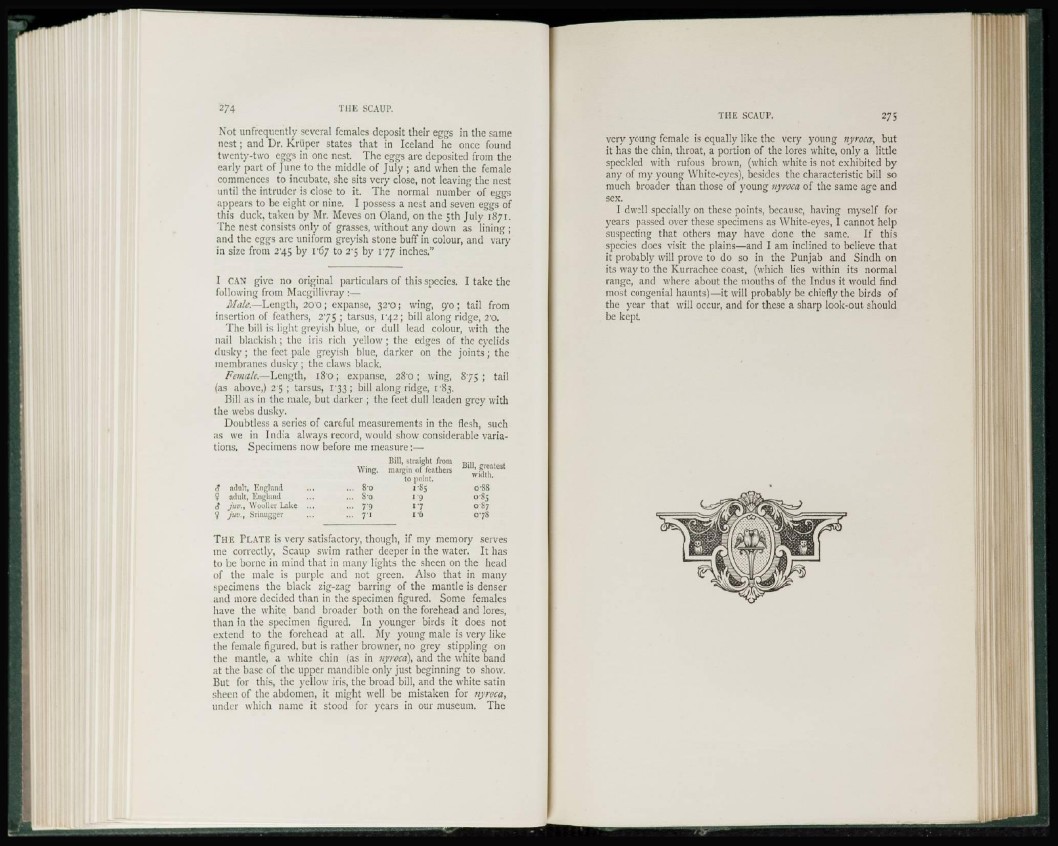
Not unfrcqucntly .several females deposit their eggs in the same
nest ; and Dr. Krtiper states that in Iceland he once found
twenty-two eggs in one nest. The eggs are deposited from the
early part of June to the middle of July ; and when the female
commences to incubate, she sits very close, not leaving the nest
until the intruder is close to it. The normal number of eggs
appears to be eight or nine. I possess a nest and seven eggs of
this duck, taken by Mr. Mcvcs on Oland, on the 5th July 1871.
The nest consists only of grasses, without any down as lining ;
and the eggs arc uniform greyish stone buff in colour, and vary
in size from 245 by 1*67 to 2-5 by 177 inches."
I CAN give no original particulars of this species. I take the
following from Macgillivray :—
Male.—Length, 200; expanse, 32'0; wing, 0/0; tail from
insertion of feathers, 275 ; tarsus, 1*42; bill along ridge, TO.
The bill is light greyish blue, or dull lead colour, with the
nail blackish ; the iris rich yellow ; the edges of the eyelids
dusky; the feet pale greyish blue, darker on the joints; the
membranes dusky ; the claws black.
Female.—Length, i8"0; expanse, 28'0 ; wing, 875; tail
(as above,) 2'5 ; tarsus, r'33 ; bill along ridge, 1-83.
Bill as in the male, but darker ; the feet dull leaden grey with
the webs dusky.
Doubtless a series of careful measurements in the flesh, such
as we in India always record, would show considerable variations.
Specimens now before me measure :—
Bill, straight from j,-,.
Wing. margin of feathers a M ' E™a t e s t
to point. Wldth"
0* adult, England ... ... 8*0 i'»5 0"88
9 adult, England ... ... 8*0 I'9 C'8s
cf jiiv., Wooller Lake ... ... 7'9 i'7 0*87
9 juv.t Srinygger ... ... 7'i i'6 0*78
THE PLATE is very satisfactory, though, if my memory serves
me correctly, Scaup swim rather deeper in the water. It has
to be borne in mind that in many lights the sheen on the head
of the male is purple and not green. Also that in many
specimens the black zig-zag barring of the mantle is denser
and more decided than in the specimen figured. Some females
have the white band broader both on the forehead and lores,
than in the specimen figured. In younger birds it does not
extend to the forehead at all. My young male Is very like
the female figured, but is rather browner, no grey stippling on
the mantle, a white chin (as in nyroca), and the white band
at the base of the upper mandible only just beginning to show.
But for this, the yellow iris, the broad bill, and the white satin
sheen of the abdomen, it might well be mistaken for nyroca,
under which name it stood for years in our museum. The
THE SCAUP. 275
very young female is equally like the very young nyroca, but
it has the chin, throat, a portion of the lores white, only a little
speckled with rufous brown, (which white is not exhibited by
any of my young White-eyes), besides the characteristic bill so
much broader than those of young nyroca of the same age and
sex.
I dwell specially on these points, because, having myself for
years passed over these specimens as White-eyes, I cannot help
suspecting that others may have done the same. If this
species does visit the plains—and I am inclined to believe that
it probably will prove to do so in the Punjab and Sindh on
its way to the Kurrachee coast, (which lies within its normal
range, and where about the mouths of the Indus it would find
most congenial haunts)—it will probably be chiefly the birds of
the year that will occur, and for these a sharp look-out should
be kept.